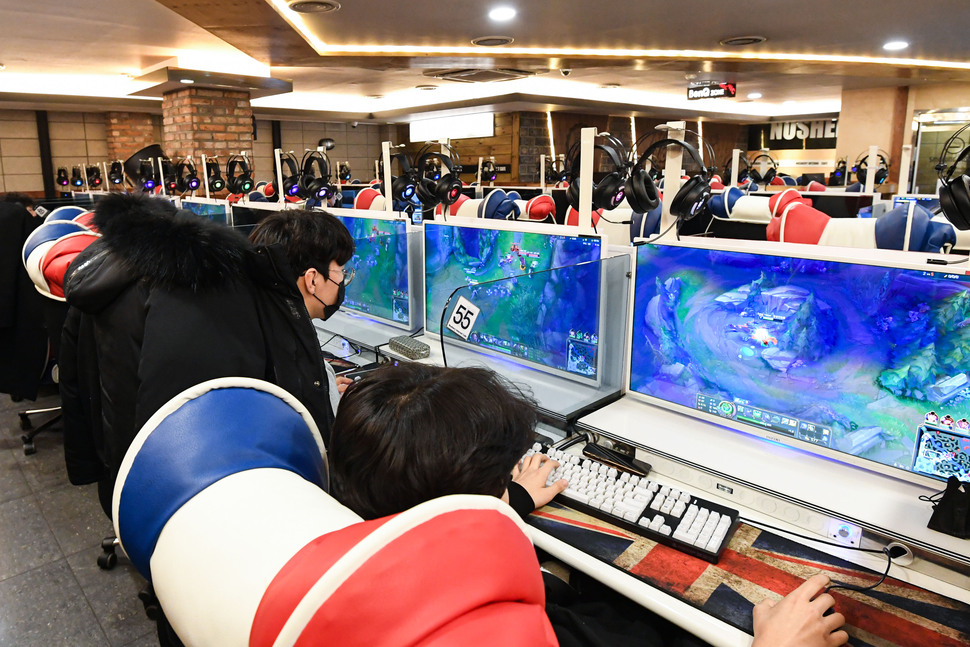[Nov] PC bangs, ballparks and K-pop stores offer unique tourist experiences
Date Nov 25, 2022
 A PC bang, Korean internet cafe, in Seoul.
A PC bang, Korean internet cafe, in Seoul.
Tourists come to Korea with their own list of things to see and do. Some are tempted by surviving examples of traditional architecture like palaces and Buddhist temples, while others want to try different kinds of food that they saw in Korean films, TV dramas or meokbang videos. Some want to catch a panoramic view of Seoul from the tops of skyscrapers or soak in the idyllic scenery of rural villages, while others want to shop around for cosmetics and other K-brands.
But Korea has much more to offer – truly unique places and things.
PC bang
Literally “PC room,” a PC bang is an internet cafe. And while other countries, of course, have internet cafes, PC bang are optimized for online games as Korea is home to many of the world’s biggest computer game developers and fans.
Pretty much every PC bang has high-speed internet connections and state-of-the-art computers here in the world’s most-wired country. Other standard offerings are professional gaming chairs as well as backlit keyboards and mouses set in front of extra-wide monitors.
Another feature that fascinates first-time PC bang visitors is the food ordering system. There is a menu icon on each monitor, and just by clicking the food or drink on the menu, users can have the food brought to their seats. The food items include not only snacks but also hot dishes such as stir-fried rice or bowls of ramyeon cooked by the staff.
Baseball cheering
Baseball fans in Korea don’t just sit and watch the game. They get wild and crazy, but not with the violent antics associated with hooligans. Instead, they stand up, sing, dance, do group performances and eat – all at the same time. These traits are what make Korea’s cheering culture unique.
Each professional baseball club has its own squad of cheerleaders as well as its own theme songs and performances that the spectators can easily become a part of. In addition, each player has his own musical theme that the cheerleaders perform when the athlete comes up to bat.
Eating is also a big part of the cheering culture. The kinds of food sold at ballparks have become more varied ever since draft beer sales were introduced in the mid-2010s. K-drama-popularized Chimaek, a combination of fried chicken and beer, can also be enjoyed at ballparks. Some stadiums operate special zones for those who are more serious about eating, like the barbeque zone at SSG Landers’ ballpark in Incheon.
 KWANGYA@SEOUL, SM Entertainment’s new cultural complex opened in November inside its Seoul headquarters. Visitors can learn about the agency’s music and artists and purchase merchandise. (Courtesy of SM Entertainment)
KWANGYA@SEOUL, SM Entertainment’s new cultural complex opened in November inside its Seoul headquarters. Visitors can learn about the agency’s music and artists and purchase merchandise. (Courtesy of SM Entertainment)
K-pop pilgrimage
As the birthplace of K-pop, this is the only country where fans might catch a glimpse of their favorite stars by visiting their management agencies, merchandise shops and other related places.
In mid-November, SM Entertainment, one of Korea’s top agencies behind K-pop groups including Super Junior, Girls’ Generation, EXO, NCT and aespa, opened a cultural complex in its headquarters in Seoul.
Named KWANGYA@SEOUL, the complex provides visitors a multi-dimensional experience inside the heart of the SM universe. The flagship store not only sells goods related to SM’s artists, but also offers a chance to learn about them through cutting-edge digital technology.
HYBE, the major agency behind K-pop juggernaut BTS, also has a museum inside its Seoul headquarters. Called HYBE Insight, the museum explains the music of its artists through the themes of sound, movement and story.
Offsite, cafes nearby expand the experience with HYBE artist–themed decorations, photos and merchandise as well as events on special occasions, such as a singer’s birthday.
**If you have any questions about this article, feel free to contact us at kocis@korea.kr.**

The Ministry of Culture, Sports and Tourism's "Korea Here & Now" work can be used under the condition of "Public Nuri Type 1 (Source Indication)."




